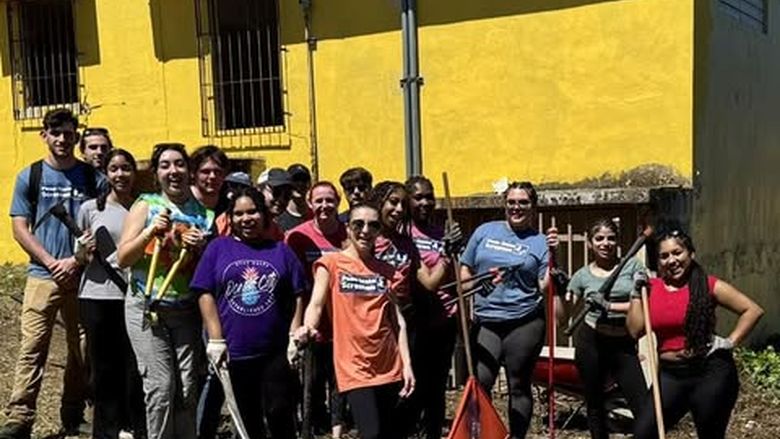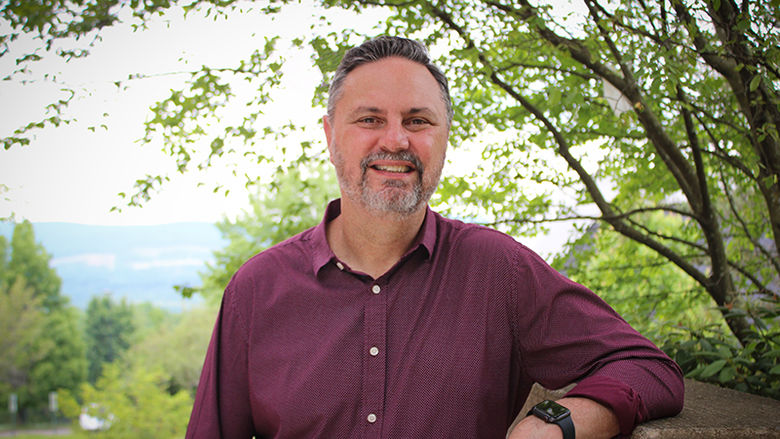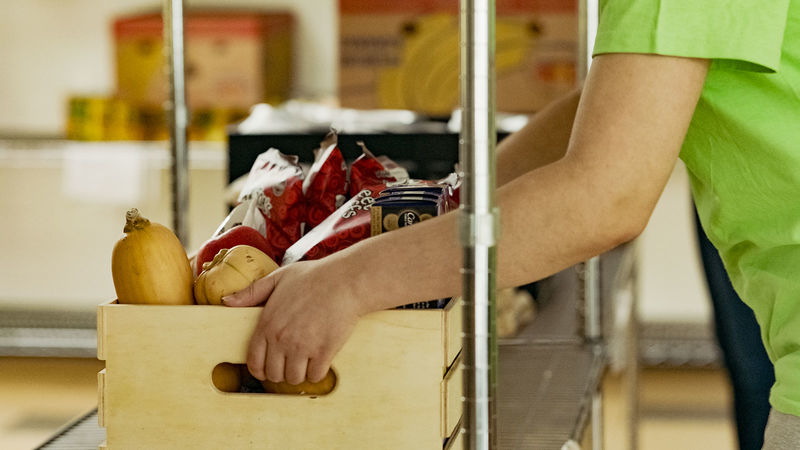

This dialog contains the full navigation menu for this site.

DUNMORE, Pa. – As the season of giving approaches, Penn State Scranton's collaboration with Child Hunger Outreach Partners (CHOP) takes on a special significance in the fight against food insecurity on campus. And, with Thanksgiving on the horizon, the campus’ seven-year commitment to maintaining a food pantry on campus gains more prominence.
Hunger and food insecurity continue to be pressing issues affecting thousands of individuals and families across the nation every day. According to PA Department of Human Services, approximately 1.7 million Pennsylvanians experience food insecurity daily.
Unfortunately, over the past seven years, those issues have affected, and continue to affect, some students at Penn State Scranton. So, in an effort to address this critical need among the campus’ student body, Penn State Scranton has forged a powerful partnership with “Chop Out Hunger” to provide vital support.
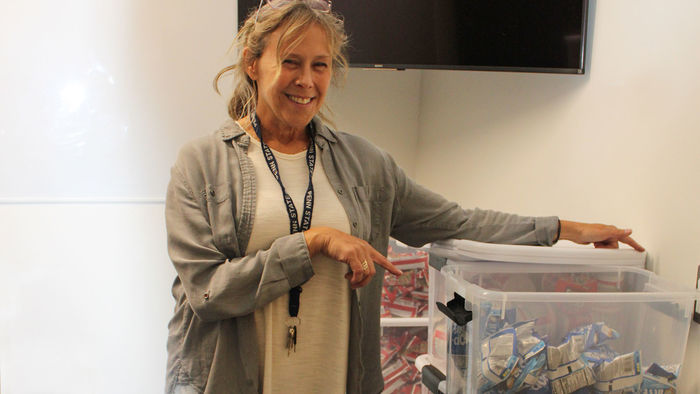
Campus Health Services Nurse Jill Thoman smiles alongside boxes filled with shelf-stable items destined for our campus food pantry, ensuring health and nourishment for our students.
Campus Health Services Nurse Jill Thoman, R.N., who has been instrumental in overseeing this initiative said the student activities department started this service after seeing a need. “I started requesting employees who wanted to join my yoga class to donate a food item, since the student activities fees paid for it. I was charged with leading this in the Fall of 2016.”
The food pantry, which is located across from the game room in the Study Learning Center, is fully stocked and readily accessible to all Penn State students. “We offer canned goods and shelf-stable items like cereal, rice, pasta and more,” Thoman said. “Since our relationship with CHOP, we have been able to offer some fresh items once in a while, such as apples, shelf-stable milk and bread.”
While some food items were initially placed in baskets in various campus buildings before the pandemic, Penn State Scranton now maintains multiple food bins throughout campus for easier access, in addition to the food pantry in the Study Learning Center.
“There is an average of 40 students utilizing this service on paper but many more unknown students that are able to take advantage of this service,” Thoman said.
The partnership with CHOP has significantly enhanced the food pantry’s capacity to assist students. “They began by stocking our shelves [to overflowing] and then we maintained a biweekly delivery that offers the opportunity to order breakfast, snack and dinner items,” she said.
“We know that oftentimes when people think of food insecurity, they think of families or small children, but we know that food insecurity also impacts young adults who may not have the support system of their younger peers,” said CHOP Communications Manager Samantha Eck. “By providing grab-and-go meals and snacks we can help close that hunger gap so that students can focus on what is most important -- their education and future,” she said.
Recognizing the importance of raising awareness about this vital resource, Thoman emphasized, “if a student is experiencing food insecurity, this can affect them academically. Being hungry creates both mental and physical stressors that affect the learning process.”
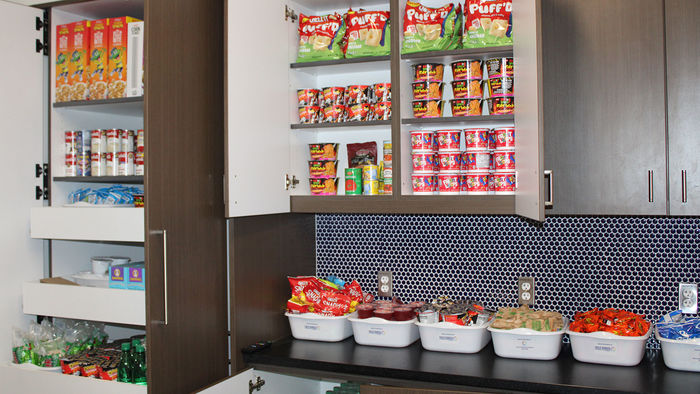
Located in the Study Learning Center, our campus food pantry, generously stocked for hungry students to grab-and-go, is made possible by our partnership with Child Hunger Outreach Partners (CHOP).
Thoman encourages students to take advantage of the food pantry’s offerings, emphasizing the potential consequences of going hungry.
“Many times, I have been called to another building for a student that feels like passing out. Upon further assessment, I have found that they have not eaten or had anything to drink. Some have told me that they used their last $5.00 to buy gas. We do not want anyone to go hungry and we have an abundance to share.”
In addition to CHOP’s support, Penn State Scranton benefits from a network of generous donors including staff, faculty, alumni and a member of the Board of Trustees at University Park who made a substantial donation to support all the Commonwealth Campuses.
Eck also emphasized the importance of encouraging students to take advantage of this resource.
“This is a free resource available to any student at the University. When more people use it, it normalizes the usage as well. Plus, we try to provide items you need or want,” she said. “We are here to make sure you have what you need when it comes to food items. If you’re hungry, you can’t show up in class at your best self.”
Last year, CHOP provided backpacks to more than 5,900 school-age children. “We also provided more, thanks to 23,122 students with access to in-school pantries,” Eck said.
This partnership between Penn State Scranton and CHOP not only addresses immediate food needs, but also enhances the commitment of the campus community to the well-being and success of students. With this collaborative effort, hungry students have a lifeline to nourishment and support, ensuring they can focus on their education without the burden of food insecurity.
One great way to support CHOP’s programs is to talk about them with peers and to volunteer. “We love to welcome groups or individuals to our Scranton branch,” Eck said.
As the collaborative effort between Penn State Scranton and CHOP continues, the impact extends beyond immediate food needs, embodying the spirit of Thanksgiving by enhancing the commitment of the campus community to the well-being and success of students.
In another heartwarming initiative for the season, Michael DeWolfe, a third-year business major, and his BA 321 classmates are giving back through a Winter Wear Coat Drive for Keystone Mission.
“Donations are the most important part, but it will be exciting to see the whole school help Keystone Mission,” said DeWolfe, hoping for widespread campus involvement.
Donation boxes were strategically placed in high-traffic areas across campus and with partnering organizations in the community, emphasizing the importance of giving back and helping those in need.
“Community service means being selfless,” DeWolfe said. “Giving time and effort without expecting anything in return is important to me. It’s important to give back because we have the privilege to have warm clothes. Helping others is important to our group.”
DeWolfe credits Penn State Scranton for providing him with the opportunity to help those in need.

Coats and hats beginning to overflow in one of the many boxes located on campus and throughout the community as part of BA 321’s service project dedicated to assisting Keystone Mission, an award-winning, local faith-based non-profit organization in Scranton and Wilkes-Barre.
“PSU shaped me as a student and as an individual [able to give] back to the community by giving me opportunities like BA 321. With great professors and a community to back me up, I have seen how fortunate I am to be able to attend this institution and have the resources I have,” DeWolfe said. “It is important to use these skills and opportunities to give back.”
Josephine Sesay, a fourth-year business major, said, “As a team, we want this drive to be successful to help the community and put smiles on people’s faces.”
The Winter Wear Drive, free and accessible to those in need, echoes the Thanksgiving spirit of gratitude and compassion.
For Sesay, community service is a way to give back to the community and foster a sense of belonging and connection.
“Giving back to those in need is important because it helps create a more compassionate and equitable society,” Sesay said. “It addresses systemic issues of inequality and provides crucial support to individuals and communities facing hardships. Additionally, helping others is a fundamental aspect of our shared humanity.”
Also making time to help others as the holiday approaches is the campus’ Student Nurses Association (SNA), which organized a food drive collection on campus to help benefit the local non-profit, Friends of the Poor.
As with the winter wear coat drive, collection boxes were distributed around campus where students, staff and faculty could drop off shelf-stable food items.
Frank Turnbaugh, a fourth-year nursing degree student and president of SNA, emphasized the importance of giving back to help those in need, especially during this season of giving.
“Community service is important to me. I think part of the reason most of us get involved in nursing and healthcare is a desire to serve and take care of people,” he said. “Penn State Scranton and Penn State’s Ross and Carol Nese College of Nursing program has helped shape me by fostering an environment that encourages service. As students, we start to recognize the need and the campus encourages our desire to help.”
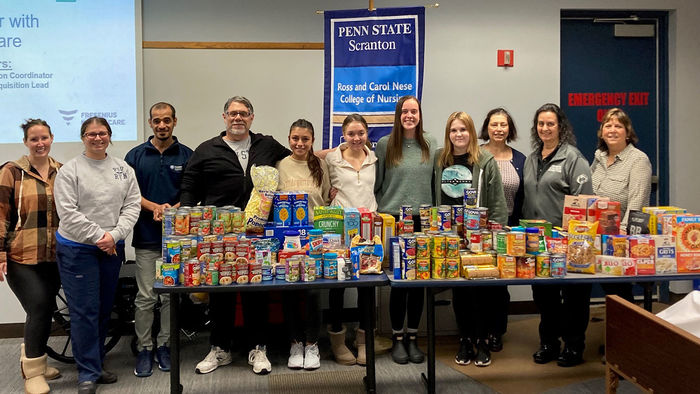
The campus’ Student Nurses Association (SNA), led by dedicated faculty and student nurses, share smiles as they gather donated food items collected for Friends of the Poor.
A true season of thanks
These and other efforts taking place on campus aimed at making the holiday season in Northeast Pennsylvania a bit brighter for those in need this holiday season, showcases the true power of giving and has fostered a sense of belonging, connection and compassion for all those involved.
The collective efforts of Penn State Scranton, CHOP, students and community partners also highlights Penn State’s Values of Integrity, Respect, Responsibility, Discover, Excellence and Community. In this case, particularly community, as these collective efforts truly emulate everyone working together for the betterment of our University and the communities we serve.
